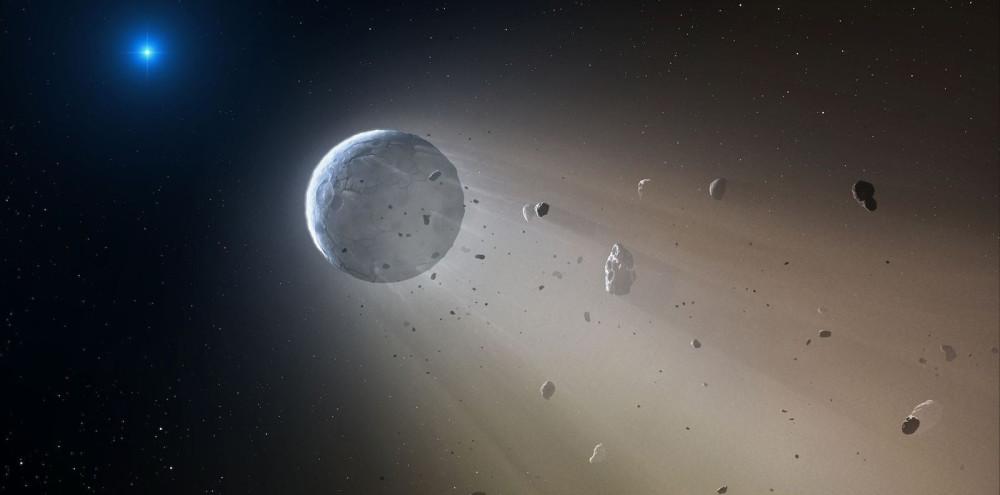Looking at the world around us, it is so colorful.
The changing seasons, the complex creatures, the humanities and sciences, the technology and civilization, no one would have thought that in billions of years, all this would be reduced to nothingness, there would be no sun in the universe, no earth, and no one would remember everything that happened here. It sounds mixed, but it's inevitable. For human beings, the earth is everything, but for the universe, the birth and demise of stars is just a normal thing, every second there are countless stars and planets born, but also countless stars and planets die. Want to know what the sun and earth will look like 5 billion years from now? Let's look beyond 413 light-years, where there was a former "sun" and a former "earth."

413 light-years away from Earth, there is a white dwarf, which is a white dwarf that has been numbered, which we call "SDSS J1288+1040".
According to current observational data, SDSS J1288+1040 has a mass of about 70% of the solar mass. Stars throw a lot of material outward during their transition to white dwarfs, and according to existing calculations, if the Sun were converted to white dwarfs, the remaining mass would be about 54.05% of the existing mass, so SDSS J1288+1040 could have been a slightly larger star than the Sun. As a white dwarf, SDSS J1288+1040 is not alone, because there is a clastic ring around it, and in the clastic ring there is also a celestial body with a diameter of more than 600 km, which is likely to be the core of a rocky planet in terms of density.
The scientists also gave the 600-kilometer-diameter object a number, "SDSS J1288+1040b."
If SDSS J1288+1040 was once a "sun", then SDSS J1288+1040b was once an "earth". Now let's go back billions of years, to when they were stars and planets, and see how they evolved to be what they are today. Once upon a time, SDSS J1288+1040b was a rocky planet, and perhaps there was life on it like Earth, orbiting a star called SDSS J1288+1040 along with other planets. Stars bring light and heat to surrounding objects, and the source of its light and heat is the fusion of hydrogen nuclei in its interior. The star's surface looks like a large, flaming fireball, but in reality its hydrogen fusion only occurs in the most core region of the interior.
The energy generated by hydrogen fusion in the central region of the star will radiate outward, so a layer of radiation is formed on the periphery of the core region, and due to the existence of the radiation region, the energy generated by nuclear fusion can only be transmitted outward, while the stellar material on the outer periphery of the radiation region cannot enter the interior of the star.
Therefore, when the fuel inside the star, that is, hydrogen, is exhausted, there is actually a large amount of hydrogen in the outer part of the star. After the fuel inside the star is exhausted, the energy generated rapidly decays, unable to resist its own gravitational pull, so the volume will begin to shrink, the volume of the contraction makes the overall temperature and pressure of the star increase, finally, the conditions for helium fusion are satisfied, in the hydrogen fusion and accumulation of helium elements in the interior of the star is ignited at once, in an instant, the star is like an explosion to release a huge amount of energy, which is helium flash.
At the same time, due to the increase in the overall temperature and pressure of the star, the hydrogen element outside the star is also ignited, so the outer layer of the star also began a nuclear fusion reaction, which is called "hydrogen shell fusion".
Because the fusion of the hydrogen shell releases huge amounts of energy, the outer layer of material in the star is blown up by the released energy, and from the appearance, the volume of the star expands sharply and becomes a red giant. Eventually, as the fusion of the star continued to push toward the heavier elements, finally running out of fuel, there was no longer any force to stop the star from collapsing further, so it became a white dwarf star that no longer glowed, and shone faintly close to the remaining temperature.
As the star expands and helium flashes, the planets around the star are shattered by the massive impact, some are engulfed by the star during the star's expansion, and the remaining ones come together to form the white dwarf's clastic rings, including SDSS J1288+1040b.
Compared to other planets, SDSS J1288+1040b is undoubtedly lucky, it has not become unrecognizable, at least there is a complete kernel left. Looking at SDSS J1288+1040 and SDSS J1288+1040b is like looking at the sun and the earth 5 billion years later, but I don't know if there will be intelligent civilizations like us who will find our wreckage and make up such a journey like us. In fact, our earth is probably not as lucky as SDSS J1288+1040b, because we are too close to the sun and are likely to be engulfed in the process of the expansion of the sun.